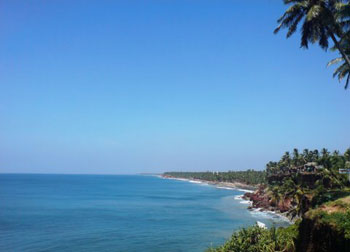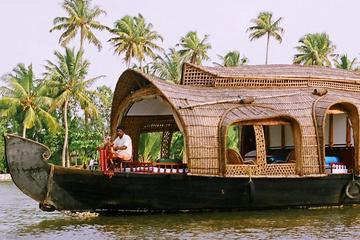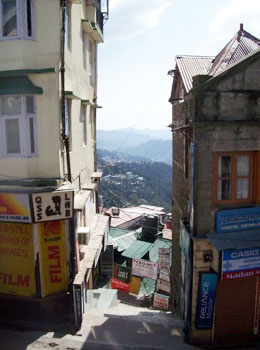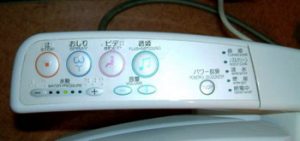
Kerala, India
by Niranjan Das
Varkala has always been there in my travel list for a long time and the two day break was apt for me to head to the small fishing hamlet.
Being in the southern part of Kerala, traveling from Bangalore was indeed a long journey. Fourteen hours was quite a bit of time, but the excitement grew as I got down at Kallambalam. It is a deviation of around 10 kilometers from this point off the NH 47 to Varkala. This is approximately 45 kms before you touch Kerala’s capital, Thiruvananthapuram.
 The auto rickshaws will drop you near the helipad from where you can see the clear blue sea. The south cliff is towards the left where you have a couple of resorts. However all action happens on the north cliff which is towards the right of helipad. I would recommend that any tourist who visits here should head for the north cliff rather than the south cliff in order to be in the middle of the action.
The auto rickshaws will drop you near the helipad from where you can see the clear blue sea. The south cliff is towards the left where you have a couple of resorts. However all action happens on the north cliff which is towards the right of helipad. I would recommend that any tourist who visits here should head for the north cliff rather than the south cliff in order to be in the middle of the action.
To be frank, I have not seen so many foreign tourists at one single place as I saw in Varkala. You hardly find any Indians other than the locals who run the shops and the restaurants. Being February, I could feel the heat slowly catching up. The best time to in fact visit Varkala would be September to January.
The cliff is a long stretch of about a kilometer and half with the sea on one side and the shops & restaurants on the other. The shopkeepers lure you with all sorts of arts and crafts which you can carry back home. Everything from woodwork, bangles, chains to apparels can be purchased from here. Though they price it high, make sure to bargain before you take your wallet out. I ended up entering almost all the shops before settling down on a small rudraksh for my wrist.
 Do not expect the markets to shut down with the sunset as the night life is simply amazing and it goes on till midnight (Bengaluru needs to learn a thing or two from Varkala). All the shops remain open and the restaurants display their fresh catch for the day to lure the tourists in the evenings.
Do not expect the markets to shut down with the sunset as the night life is simply amazing and it goes on till midnight (Bengaluru needs to learn a thing or two from Varkala). All the shops remain open and the restaurants display their fresh catch for the day to lure the tourists in the evenings.
Drinking beer and having the sea breeze hitting my face in the darkness of the night with a tinge of music in the background gave me a high which no cocktail has ever given ’til date. The restaurants are quite expensive but never restrict yourself from exploring the delicious sea food. They do have live bands and they keep playing and dancing until midnight.
 Rarely do you find a cliff next to a beach, but, Varkala is where you can say, YES…its right here. From the top of the cliff steps take you down to the clear blue waters. Must appreciate the authorities for the way they have maintained the beach. It is the most well kept beach that I have ever been to. The waters are not very deep for about 100 meters. However the tides are quite strong. The tourists frolic the beach from the morning. I found people doing yoga, practicing karate, taking a sun bath, jogging etc. I actually found many just playing with the tides the whole day. With safe guards always roaming around tourists found it all the more safe.
Rarely do you find a cliff next to a beach, but, Varkala is where you can say, YES…its right here. From the top of the cliff steps take you down to the clear blue waters. Must appreciate the authorities for the way they have maintained the beach. It is the most well kept beach that I have ever been to. The waters are not very deep for about 100 meters. However the tides are quite strong. The tourists frolic the beach from the morning. I found people doing yoga, practicing karate, taking a sun bath, jogging etc. I actually found many just playing with the tides the whole day. With safe guards always roaming around tourists found it all the more safe.
The sunset view from the top of the cliff is one of the best you can ever see.
This is one place you should go to if you want to just laze around. The feel of going back home would never be there. I just did not feel like leaving the clear blue waters, the fine sand and the beautiful sunsets. This is the best beach I have been to and for the sheer beauty of the place I will go back again for a longer vacation.

Trivandrum Private Tour: Overnight Alleppey Backwaters Houseboat Cruise
If You Go:
Location – Southern Kerala, South India.
Best Time to visit – October to February
Nearest Airport & Railway station – Thiruvananthapuram (Trivandrum)
Distance – Thiruvananthapuram (55 Kms)
Other places of Interest – Thiruvananthapuram, Kovalam, Kanyakumari
Accommodation – Numerous hotels are available besides the beach, on the cliff.
About the author:
Niranjan is a person who is passionate about travel. Be it long bike rides or treacherous trekking or leisure holidaying or backpacking through the countryside or an engrossing train journey, Niranjan loves to do anything and everything that involves travel. He dreams of setting foot on every single country on planet earth and meeting adorable strangers, learning new tongue twister languages, tasting mouth watering food (not a foodie though), studying vibrant cultures and exploring exotic places. www.rajniranjandas.blogspot.com
All photos are by Niranjan Das.


 As my husband Rick and I plod through the soft sand, Coney Island comes to mind. Smiling tots bob up and down on carousels and youths shriek from wildly-whirling contraptions, horses gallop by with riders, and kites fill the sky. Most amazing are the girls aged between six and ten performing daring feats on tightropes affixed to crossed bamboo poles lodged in the sand. Snack food is sold out of tents and stalls, some with gaudy plastic stools out front for customers. We agree this is our most exhilarating beach walk to date.
As my husband Rick and I plod through the soft sand, Coney Island comes to mind. Smiling tots bob up and down on carousels and youths shriek from wildly-whirling contraptions, horses gallop by with riders, and kites fill the sky. Most amazing are the girls aged between six and ten performing daring feats on tightropes affixed to crossed bamboo poles lodged in the sand. Snack food is sold out of tents and stalls, some with gaudy plastic stools out front for customers. We agree this is our most exhilarating beach walk to date. St. Thomas (San Thome) Basilica (built in 1504, and rebuilt in 1893) is renowned for its neogothic elegance, and for an underground chapel where I stand riveted at the thought of “doubting Thomas”, one of the twelve Apostles of Christ being buried here. This is one of three churches in the world proclaimed to be built over the tomb of an Apostle (the others being St. Peter’s Basilica in Rome, and Cathedral of Santiago de Compostela built over the tomb of St. James in Spain).
St. Thomas (San Thome) Basilica (built in 1504, and rebuilt in 1893) is renowned for its neogothic elegance, and for an underground chapel where I stand riveted at the thought of “doubting Thomas”, one of the twelve Apostles of Christ being buried here. This is one of three churches in the world proclaimed to be built over the tomb of an Apostle (the others being St. Peter’s Basilica in Rome, and Cathedral of Santiago de Compostela built over the tomb of St. James in Spain).
 Dharma leads us to the 12m high and 30m wide exquisite bas relief known as Arjuna’s Penance. Dharma points out the key figure saying, “Arjuna is balanced on one leg with arms upraised in ‘penance’, which in the Hindu religion does not mean repentance, but rather a gaining of power over the gods.” Arjuna’s motive was to garner the sword from the towering figure of Shiva beside him, with which to kill his enemies. Our imaginations soar as our eyes scan the 100 sculptured forms surrounding the central figures, depicting lesser gods, humans, flying creatures, and animals, including two life-sized elephants.
Dharma leads us to the 12m high and 30m wide exquisite bas relief known as Arjuna’s Penance. Dharma points out the key figure saying, “Arjuna is balanced on one leg with arms upraised in ‘penance’, which in the Hindu religion does not mean repentance, but rather a gaining of power over the gods.” Arjuna’s motive was to garner the sword from the towering figure of Shiva beside him, with which to kill his enemies. Our imaginations soar as our eyes scan the 100 sculptured forms surrounding the central figures, depicting lesser gods, humans, flying creatures, and animals, including two life-sized elephants. Over a thousand years later, the tapping of hammer and chisel continues along the dusty streets of this village renowned for its stone carving. We become absorbed watching artisans chip granite blocks into animal forms and gods destined for temples around the world.
Over a thousand years later, the tapping of hammer and chisel continues along the dusty streets of this village renowned for its stone carving. We become absorbed watching artisans chip granite blocks into animal forms and gods destined for temples around the world. Another Kanchipuram stop was to a family silk weaving factory where some of the most astoundingly beautiful wedding saris are made with vividly coloured silk threads, the borders spun with gold and silver strands, and costing up to 50,000 Rupees ($1,190) – expensive for the country’s economy. Eighty percent of the city’s population is involved in the silk industry.
Another Kanchipuram stop was to a family silk weaving factory where some of the most astoundingly beautiful wedding saris are made with vividly coloured silk threads, the borders spun with gold and silver strands, and costing up to 50,000 Rupees ($1,190) – expensive for the country’s economy. Eighty percent of the city’s population is involved in the silk industry. Just over the border from Puducherry is Auroville, the brainchild of “the Mother”, whose work has been carried on by her followers. Although there is minimal tourist access of the facility, a visitor centre provides information on the workings of this international community that is spread over 20 sq km, with about 2,000 residents from around 38 nations. It is a place to live in peace and unity – above all creeds, politics, and nationalities. The focal point of Auroville is a gigantic gold-plated globe called the Matrimandir, which contains a crystal that diffuses sunlight into 26 meditation chambers for use by its members.
Just over the border from Puducherry is Auroville, the brainchild of “the Mother”, whose work has been carried on by her followers. Although there is minimal tourist access of the facility, a visitor centre provides information on the workings of this international community that is spread over 20 sq km, with about 2,000 residents from around 38 nations. It is a place to live in peace and unity – above all creeds, politics, and nationalities. The focal point of Auroville is a gigantic gold-plated globe called the Matrimandir, which contains a crystal that diffuses sunlight into 26 meditation chambers for use by its members.

 I booked myself onto an overnight bus, barely sleeping through a cold night on winding roads, waiting for the dawn to break. When it did, I watched us pass through villages and market towns, women hurrying through the morning wrapped in thick shawls, men drinking steaming tea at roadside shops, children bright-faced with cold and smiling, all backed by green slopes and snowy peaks. This India looked very different to the hot plains I knew.
I booked myself onto an overnight bus, barely sleeping through a cold night on winding roads, waiting for the dawn to break. When it did, I watched us pass through villages and market towns, women hurrying through the morning wrapped in thick shawls, men drinking steaming tea at roadside shops, children bright-faced with cold and smiling, all backed by green slopes and snowy peaks. This India looked very different to the hot plains I knew.
 “Is there snow in Solang?” I asked.
“Is there snow in Solang?” I asked. The summer capital of the British Raj, Shimla is strung out along a high, green ridge, overlooking deep valleys covered in trees. Its streets are stepped like rice terraces, connected by steep staircases. The buildings are all oddly familiar in Shimla – bay-windowed houses with chimneys and pointed roofs, the Raj’s version of home, tumbling down the mountainside. There are two Shimlas – the Indian town, a steep warren of shops and stalls, and the European town, with broad buildings spread out around a wide boulevard, and into the trees on the edge of town.
The summer capital of the British Raj, Shimla is strung out along a high, green ridge, overlooking deep valleys covered in trees. Its streets are stepped like rice terraces, connected by steep staircases. The buildings are all oddly familiar in Shimla – bay-windowed houses with chimneys and pointed roofs, the Raj’s version of home, tumbling down the mountainside. There are two Shimlas – the Indian town, a steep warren of shops and stalls, and the European town, with broad buildings spread out around a wide boulevard, and into the trees on the edge of town. Having had my fill of Shimla’s ghostliness, I got another bus to Dharamsala, home of the Dalai Lama. Dharamsala itself is a bustling but unremarkable mountain town, but above it is McLeod Ganj, seat of the Tibetan government, and with a population of mostly Tibetan refugees and western tourists. Many of them come to take Buddhist meditation classes, or to hear one of the Dalai Lama’s teachings. I came to eat Tibetan food, try out the hospitality in Tibetan bars, and gaze at the views over the valley, of rocky villages and strings of colourful Buddhist prayer flags.
Having had my fill of Shimla’s ghostliness, I got another bus to Dharamsala, home of the Dalai Lama. Dharamsala itself is a bustling but unremarkable mountain town, but above it is McLeod Ganj, seat of the Tibetan government, and with a population of mostly Tibetan refugees and western tourists. Many of them come to take Buddhist meditation classes, or to hear one of the Dalai Lama’s teachings. I came to eat Tibetan food, try out the hospitality in Tibetan bars, and gaze at the views over the valley, of rocky villages and strings of colourful Buddhist prayer flags.
 I booked into a cabin at a reasonably clean home-stay and deciding to leave the Jars till the next day, set out to explore the humble streets. Drifting into a cheap café for lunch, I chanced upon a middle-aged Brit we’ll call Basil. He was a handsome older fellow with an air of action about him. Nevertheless poor Basil was desperate for conversation and fell upon me, inviting me to join his table. Weary from a week full of shenanigans in Vientiane I was not overly pleased. However it would have been unspeakably churlish to decline. Over a couple of Beer Laos and a bowl of steamy noodles he told me his story.
I booked into a cabin at a reasonably clean home-stay and deciding to leave the Jars till the next day, set out to explore the humble streets. Drifting into a cheap café for lunch, I chanced upon a middle-aged Brit we’ll call Basil. He was a handsome older fellow with an air of action about him. Nevertheless poor Basil was desperate for conversation and fell upon me, inviting me to join his table. Weary from a week full of shenanigans in Vientiane I was not overly pleased. However it would have been unspeakably churlish to decline. Over a couple of Beer Laos and a bowl of steamy noodles he told me his story.
 The focus of Basil’s job was to train up local lads to be defusers themselves. They were brave, good-hearted souls, but so gung-ho to get stuck in he feared for their lives.
The focus of Basil’s job was to train up local lads to be defusers themselves. They were brave, good-hearted souls, but so gung-ho to get stuck in he feared for their lives. So there I was, sat in the Unexploded Bomb Land Rover, speeding out into the dark deserted moors. All around was nothing but black fields and bombs. On we drove, up and down, over hills and through vales. Then abruptly … there it was!
So there I was, sat in the Unexploded Bomb Land Rover, speeding out into the dark deserted moors. All around was nothing but black fields and bombs. On we drove, up and down, over hills and through vales. Then abruptly … there it was! As we motored back to Phonsavan’s version of civilization, I pondered my companion. It’s true to say that left-wing liberals like me find it difficult to bond with macho army types like Basil. On the other hand, his sacrifice of time and safety to the people of Laos deserved nothing but awe and admiration. I had come to respect him, despite his problems in adjusting to local customs. Usually I can’t stand westerners who come out to Asia and whinge. As a famous Catholic missionary in Bangkok once told me: shut up or ship out. Perhaps my encounter with Basil taught me to be less fussy.
As we motored back to Phonsavan’s version of civilization, I pondered my companion. It’s true to say that left-wing liberals like me find it difficult to bond with macho army types like Basil. On the other hand, his sacrifice of time and safety to the people of Laos deserved nothing but awe and admiration. I had come to respect him, despite his problems in adjusting to local customs. Usually I can’t stand westerners who come out to Asia and whinge. As a famous Catholic missionary in Bangkok once told me: shut up or ship out. Perhaps my encounter with Basil taught me to be less fussy.









